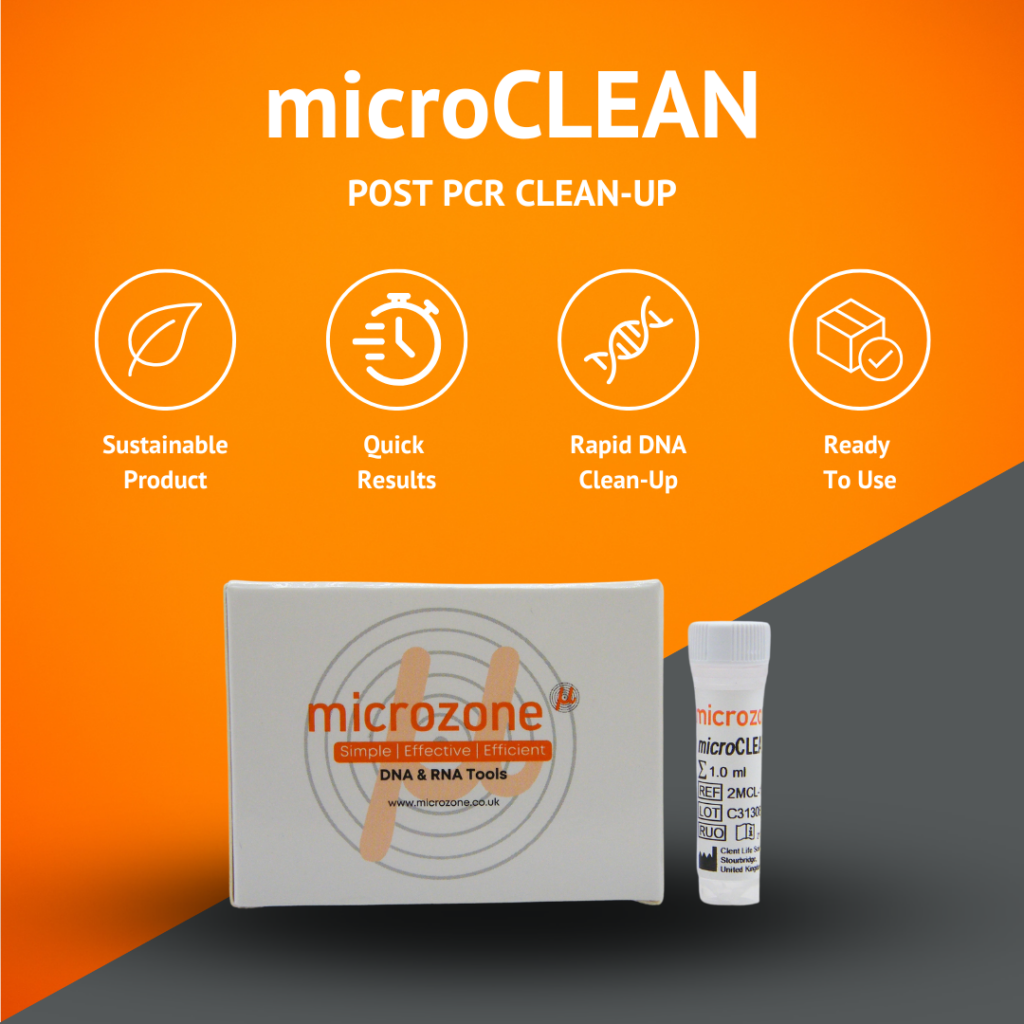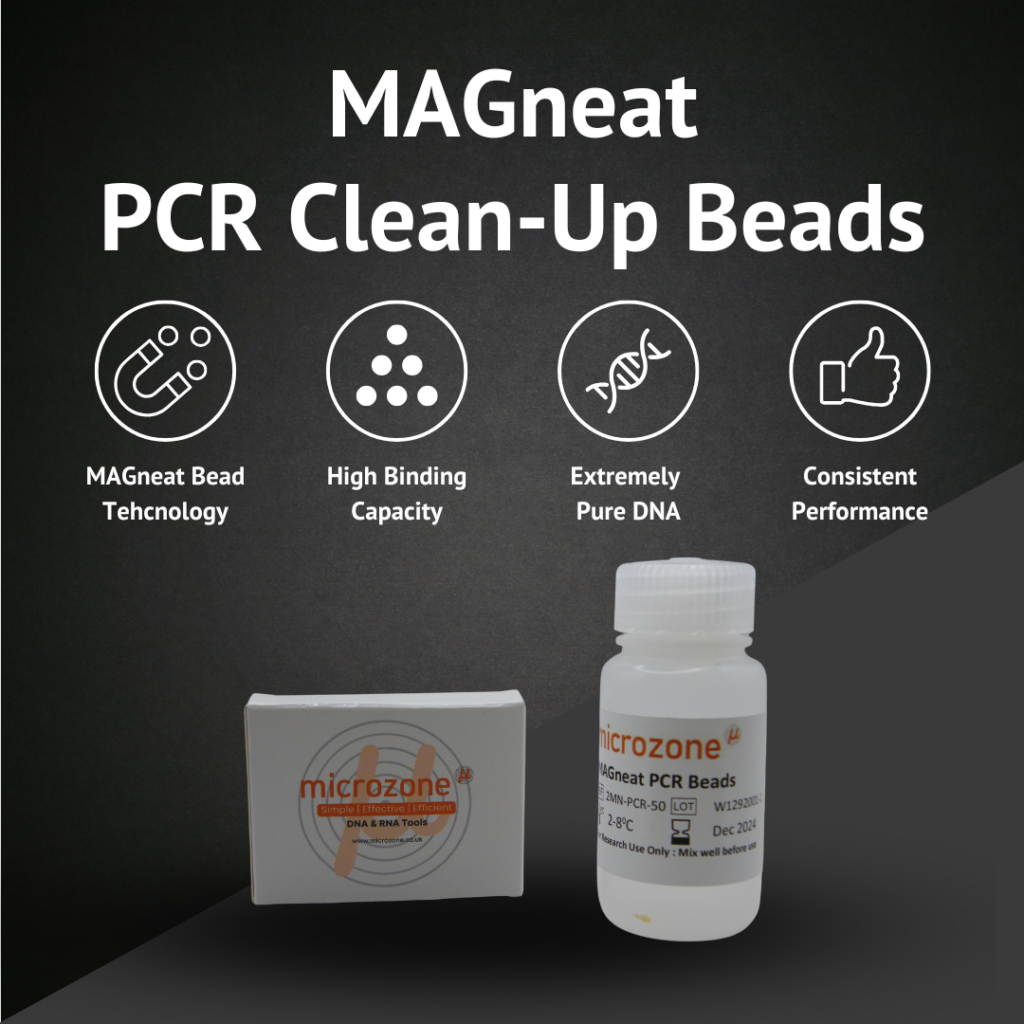Your basket is currently empty!

PCR Product Purification Techniques: Complete Guide
In this guide we’ll explain the various PCR Product Purification techniques, their unique strengths, drawbacks and when they are most appropriate to choose.
Polymerase Chain Reaction (PCR) is a cornerstone technique in molecular biology, enabling the amplification of specific DNA sequences. However, post-PCR, the amplified products often require purification to remove residual primers, nucleotides, enzymes, and other reaction components. This purification is crucial for downstream applications such as sequencing and cloning. Several PCR product purification techniques are available, each with its own advantages and limitations.
Among the most commonly used methods are Phenol-Chloroform Extraction, Spin Column Purification, Enzymatic Clean-Up, Magnetic Bead-Based Purification, and microCLEAN from Microzone. These techniques ensure the removal of contaminants, providing high-quality DNA suitable for further analysis and experimentation.
Phenol-Chloroform Purification
The first of several PCR product purification techniques we’ll review is Phenol-chloroform extraction. This is a classic method for DNA purification that involves the use of phenol and chloroform to separate proteins and other contaminants from DNA. Mix the PCR product with phenol and chloroform, then centrifuge the mixture to create a phase separation. Collect the aqueous phase containing the DNA, and precipitate the DNA with ethanol or isopropanol.
What are the pros of Phenol-Chloroform Purification?
- High Purity: Phenol-chloroform extraction effectively removes proteins and other contaminants, producing highly pure DNA.
- Versatility: Use this method for a wide range of applications, including the purification of DNA from complex biological samples.
What are the drawbacks of Phenol-Chloroform Purification?
- Toxicity and Safety Concerns: Phenol and chloroform are hazardous chemicals that require careful handling and proper disposal, posing safety risks to laboratory personnel.
- Time-Consuming: The method involves multiple steps, including phase separation and DNA precipitation, which can be time-consuming compared to other purification techniques.
- Labor-Intensive: Requires meticulous handling and multiple steps, increasing the risk of sample loss or contamination.
When to use Phenol-Chloroform Purification?
- Use this method in situations where the highest purity of DNA is required, such as in certain diagnostic or forensic applications.
- Laboratories equipped to handle hazardous chemicals and perform complex procedures.
Spin Column Purification
Spin column purification is a widely used PCR product purification technique that relies on the affinity of DNA for silica membranes in the presence of chaotropic salts and solvents. During the process, mix the PCR product with a binding buffer and apply it to the column. The DNA binds to the silica membrane, while washing steps remove impurities. Finally, elute the purified DNA in a low-salt buffer or water.
What are the pros of Spin Column Purification?
- Simplicity and Speed: The procedure is designed to be quick and straightforward, often taking no more than 15-30 minutes. This makes it an attractive option for routine use in many laboratories.
- Good Yield and Purity: Spin column purification is known for delivering high yields of purified DNA with minimal contaminants, making it suitable for a range of downstream applications such as cloning, sequencing, and PCR.
- Convenience: Commercial kits are readily available, including all necessary reagents and detailed protocols, which simplifies the process for users.
What are the drawbacks of Spin Column Purification?
- Cost: The cost per sample is often considerably higher compared to some other methods, particularly when processing a large number of samples.
- Limitations with Small Fragments: This method is less effective at purifying very small DNA fragments, which may not bind efficiently to the silica membrane.
- Plastic Waste: The use of spin columns generates a significant amount of plastic waste, which can be an environmental concern, especially in high-throughput settings.
- Requires Solvents: Requires solvents, such as isopropanol and/or ethanol for binding and wash steps.
When to use Spin Column Purification?
- Routine purification of PCR products for applications that require high-quality DNA in labs when cost is not an issue.
Enzymatic Clean-Up
Enzymatic clean-up is a method that employs specific enzymes to degrade unwanted components in the PCR mixture. Typically, exonuclease I and alkaline phosphatase are used to digest remaining primers and dephosphorylate nucleotides, respectively. The process involves adding these enzymes to the PCR product, incubating for a short period, and then inactivating the enzymes, leaving behind the purified DNA.
What are the pros of Enzymatic clean-up?
- Simple and Quick: The method involves minimal handling steps and short incubation times, usually completed within 30 minutes to an hour, making it suitable for high-throughput applications.
- Cost-Effective: Compared to column-based methods, enzymatic clean-up is generally more affordable, reducing per-sample costs.
What are the drawbacks of Enzymatic clean-up?
- Incomplete Clean-Up: There is a possibility that not all contaminants will be removed, especially in reactions with high concentrations of residual primers or nucleotides. This would interfere with sensitive downstream applications.
- Residual Enzymes: Enzymes used in the clean-up process need to be inactivated or removed, which can be an additional step in some downstream applications.
When to use Enzymatic clean-up?
- Laboratories that require a quick and cost-effective purification method, particularly in high-throughput settings.
- Applications where absolute purity is not as critical but where removal of primers and nucleotides is necessary.
Magnetic Bead-Based Purification
Magnetic bead-based purification, such as MAGneat PCR Clean Up Beads by Microzone, utilises magnetic beads coated with substances that selectively bind DNA in the presence of appropriate binding buffers. The process involves mixing the PCR product with the beads, capturing the beads using a magnet, washing to remove impurities, and finally eluting the purified DNA.
What are the pros of Magnetic Bead-Based Purification?
- Scalability: Laboratories that process large numbers of samples can easily scale up the method, making it ideal for high-throughput applications.
- High Yield and Purity: Magnetic bead-based purification generally offers high yields of purified DNA with excellent purity, suitable for sensitive downstream applications.
- Automation-Friendly: Integrating this technique into automated systems enhances efficiency and consistency in large-scale processing.
What are the drawbacks of Magnetic Bead-Based Purification?
- Cost: The initial setup costs can be higher due to the need for magnetic racks, expensive automation and potentially higher per-sample costs compared to other methods.
- Complexity: Optimizing for different types of PCR products and specific applications may add complexity to the procedure.
- Requires Solvents: Requires solvents, such as isopropanol and/or ethanol for binding and wash steps.
When to use Magnetic Bead-Based Purification?
- High-throughput laboratories and applications that require automation for processing large sample volumes.
- Situations where obtaining high yield and purity of DNA is critical, such as next-generation sequencing (NGS) and other sensitive applications.
microCLEAN from Microzone
Microzone developed microCLEAN, a proprietary PCR purification reagent, as part of our Free From range of reagents. We designed this range to simplify molecular biology workflows. It uses proprietary buffer technology to precipitate DNA onto the tube wall, streamlining the purification process. The combination of the binding and washing steps allows the whole process to take place in a single tube, reducing handling steps, potential for error, and plastic waste. The method involves adding the microCLEAN reagent to the PCR product, a short centrifugation step, removal of the supernatant and elution.

What are are the pros of microCLEAN?
- Efficiency: The microCLEAN method significantly simplifies the purification process, saving time and reducing the potential for sample loss or contamination.
- Speed: The process takes less than 20 minutes start to finish.
- Versatility: This method is suitable for a wide range of downstream applications, including sequencing, cloning, and other molecular biology techniques that require purified DNA.
- Cost-Effective: Compared to other commercial purification kits, microCLEAN is more affordable, making it a cost-effective choice for many laboratories.
- Environmentally Friendly: microCLEAN uses a single tube for the entire purification process, significantly reducing plastic waste compared to spin column methods.
- Safe: Doesn’t require harmful chemicals and solvents.
- High Yield and Purity: microCLEAN offers high yields of purified DNA with excellent purity, suitable for sensitive downstream applications.
What are the drawbacks of microCLEAN?
- Medium Throughput: While efficient for small to moderate numbers of samples using tube or plates, microCLEAN may not be as scalable as magnetic bead-based methods for very high-throughput needs and automation.
When to use microCLEAN?
- Laboratories seeking a cost-effective and efficient purification method that balances simplicity with high recovery rates.
- Researchers requiring a versatile solution for various downstream applications without compromising on DNA quality and purity.
- Environmentally conscious laboratories looking to minimise plastic waste.
- Small/remote laboratories with limited access to equipment or solvents.
You can learn more about microCLEAN and our streamlined workflow by exploring our Free From range.
Choosing the Best PCR Product Purification Technique for Optimal Results
Selecting the appropriate option from the wide variety of PCR product purification techniques is contingent on various factors, including the specific requirements of the downstream application, available resources, and throughput needs.
Phenol-chloroform extraction provides high-purity DNA but involves hazardous chemicals and is labor-intensive.
Spin column purification offers a balance of ease of use, good yield, and purity but generates significant plastic waste and is costly.
Enzymatic clean-up provides a quick and cost-effective solution but is often not suitable for sensitive applications such as sequencing as inhibitors remain.
Magnetic bead-based purification excels in scalability and automation, making it ideal for large-scale processing where high yield and purity are essential.
Finally, microCLEAN from Microzone stands out as an efficient, versatile, and environmentally friendly option with high recovery rates, suitable for a broad range of applications.
By understanding the strengths and limitations of these techniques, researchers can select the most appropriate method for their specific needs, ensuring the best outcomes for their molecular biology workflows.
Featured Products

microCLEAN – PCR Product Clean Up

